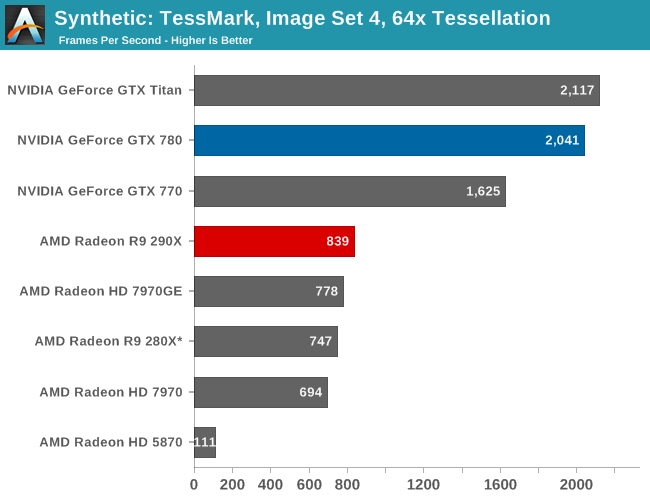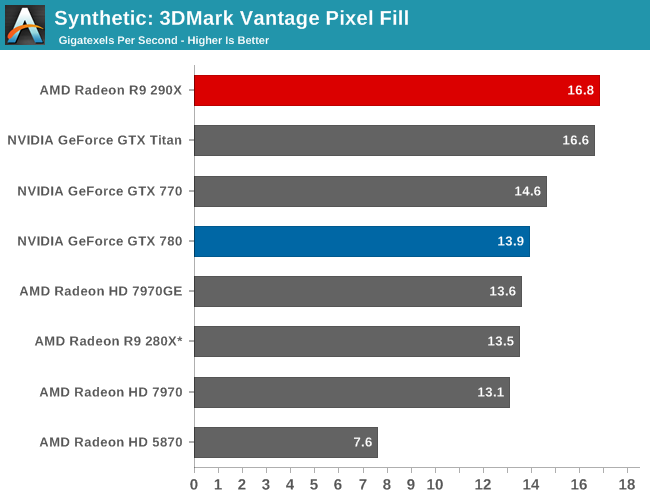The AMD Radeon R9 290X Review
by Ryan Smith on October 24, 2013 12:01 AM EST- Posted in
- GPUs
- AMD
- Radeon
- Hawaii
- Radeon 200
Synthetics
As always we’ll also take a quick look at synthetic performance. The 290X shouldn’t pack any great surprises here since it’s still GCN, and as such bound to the same general rules for efficiency, but we do have the additional geometry processors and additional ROPs to occupy our attention.

Right off the bat then, the TessMark results are something of a head scratcher. Whereas NVIDIA’s performance here has consistently scaled well with the number of SMXes, AMD’s seeing minimal scaling from those additional geometry processors on Hawaii/290X. Clearly Tessmark is striking another bottleneck on 290X beyond simple geometry throughput, though it’s not absolutely clear what that bottleneck is.
This is a tessellation-heavy benchmark as opposed to a simple massive geometry bencehmark, so we may be seeing a tessellation bottleneck rather than a geometry bottleneck, as tessellation requires its own set of heavy lifting to generate the necessary control points. The 12% performance gain is much closer to the 11% memory bandwidth gain than anything else, so it may be that the 280X and 290X are having to go off-chip to store tessellation data (we are after all using a rather extreme factor), in which case it’s a memory bandwidth bottleneck. Real world geometry performance will undoubtedly be better than this – thankfully for AMD this is the pathological tessellation case – but it does serve of a reminder of how much more tessellation performance NVIDIA is able to wring out of Kepler. Though the nearly 8x increase in tessellation performance since 5870 shows that AMD has at least gone a long way in 4 years, and considering the performance in our tessellation enabled games AMD doesn’t seem to be hurting for tessellation performance in the real world right now.
Moving on, we have our 3DMark Vantage texture and pixel fillrate tests, which present our cards with massive amounts of texturing and color blending work. These aren’t results we suggest comparing across different vendors, but they’re good for tracking improvements and changes within a single product family.

Looking first at texturing performance, we can see that texturing performance is essentially scaling 1:1 with what the theoretical numbers say it should. 36% better texturing performance over 280X is exactly in line with the increased number of texture units versus 280X, at the very least proving that 290X isn’t having any trouble feeding the increased number of texture units in this scenario.

Meanwhile for our pixel fill rates the results are a bit more in the middle, reflecting the fact that this test is a mix of ROP bottlenecking and memory bandwidth bottlenecking. Remember, AMD doubled the ROPs versus 280X, but only gave it 11% more memory bandwidth. As a result the ROPs’ ability to perform is going to depend in part on how well color compression works and what can be recycled in the L2 cache, as anything else means a trip to the VRAM and running into those lesser memory bandwidth gains. Though the 290X does get something of a secondary benefit here, which is that unlike the 280X it doesn’t have to go through a memory crossbar and any inefficiencies/overhead it may add, since the number of ROPs and memory controllers is perfectly aligned on Hawaii.










396 Comments
View All Comments
Ytterbium - Thursday, October 24, 2013 - link
The 290 is the binned version 290X is the topAtiom - Thursday, October 24, 2013 - link
Time to cut the Titan price to less than half!!!!!!TheJian - Friday, October 25, 2013 - link
Sure as soon as 290x gets the compute abilities in pro apps that Titan has (the Tesla side of Titan). 3 AAA games, less heat, less noise, less watts, physx, cuda, pro apps perf and 6GB of memory. All that adds up to HIGHER PRICING than 290x. Tesla is $2500.MADDER1 - Thursday, October 24, 2013 - link
Awesome! We need this for CPUs too!Ytterbium - Thursday, October 24, 2013 - link
I'd prefer the review was finished before posting.Hxx - Thursday, October 24, 2013 - link
why do people compare this to the titan? Nobody buys a titan card unless they absolutely must have the fastest nvidia card. Its like buying a Lambo. How many other cars can you buy with less money that are just as fast if not faster....its like bragging rights for geeks, or in Lambo's case bragging rights for rich old folks.Gigaplex - Thursday, October 24, 2013 - link
What does that have to do with the complaint that the review shouldn't be posted before it has been finished?aTaoZ - Thursday, October 24, 2013 - link
Looks like the 290X's power regulation is really working. It's able to run at a specific temperature.Because of it, many games will run at lower core frequencies than 1GHz. Once the non-reference cooling solutions arrive, there will be even more performance coming out of these cards.In LegitReview's article, they dropped the target temperature to 65 Celsius, and the performance seems to drop between 7-20% depending on application.
HisDivineOrder - Friday, October 25, 2013 - link
I suspect the card was actually built to run at 80-85, but when they saw the performance wouldn't be hitting at Titan-killer levels, they boosted it to 95 and said, "Yeah, it'll hold."I think some custom coolers and especially water cooling should make this card fly, but the default cooler is one of those tragedies that just makes you shake your head.
Owls - Thursday, October 24, 2013 - link
[comment in progress]